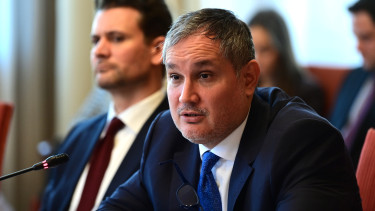COVID-19: New daily cases hit all-time high in Hungary, and that's not even the biggest problem


After a jump to over 30% the positivity rate returned to 23.99% and further to 21.74% as authorities performed more tests, nearly 45,000 tests on Wednesday and almost 52,000 on Thursday. This change in the percent positive is good news and suggests (you'll see why in a follow-up article) that the positivity rate will peak around 5 December.
Two key remarks regarding today's data: 1) About 4 to 5% of the 11,000 people diagnosed with SARS-CoV-2 yesterday will die within 25 days, which translates into 500 to 600 Covid-related deaths. 2) A single day's percent positive figure can cause a dramatic shift in the prognosis even for just four weeks forward. This strongly suggests that the quality of data is extremely shabby. A single day's figure should not induce such a massive change.


Hungarian health care system under increasing load
The Hungarian Medical Chamber (MOK) warned on Wednesday that amidst a surging in the number of new COVID-19 cases intensive care units are filling up fast. Beyond a certain point their number cannot be further increased rationally because staff required to attend the patients there is running thin.
The chamber warns that with so few professional nurses and doctors attending to coronavirus patients in severe condition we can expect a high percentage of ventilated patients to die, even in international terms, just like during the ‘third wave’ of the pandemic. The chamber urged the government to implement new restriction measures, alerting the public that without these hospitals will eventually find themselves under wartime conditions.
The Hungarian government decided on Thursday to implement a few restriction measures as a response to the surging number of daily new COVID-19 cases and related hospitalisations. No curfew, and no lockdown measures will be put in place, though, which was expected, as the cabinet continues to bet almost exclusively on vaccines and is reluctant to impose measures that would dent economic growth.
- mask-wearing will be compulsory indoors as of Saturday (20 Nov);
- as regards services, mask-wearing will be compulsory where there are generally more than five customers at once;
- deciding on mask-wearing in schools is at the discretion of the principals, the government only recommends that they do order it;
- events with more than 500 people in attendance can be visited only with immunity certificate (this is not a new measure);
- 3rd doses of a COVID-19 vaccine will be mandatory for health care workers (within four to seven months after their second jab).
The tables below show how the changes in the number of daily new confirmed COVID-19 cases, hospitalisations and the number of ventilated Covid patients in 2021 and 2020.
In the top chart we compared the figures of 18 November to one, two, three, and four weeks earlier. The second chart shows the week-on-week changes. The red cells make it evident that the epidemiological situation has been worsening at a more alarming rate in almost every aspect than in the base period.
We have already written about the growing load on hospitals, and experts keep warning about it almost every day.


The number of Covid patients admitted to hospitals and needing mechanical ventilation has been on the rise for a while now, and they are already at early-May, end-April levels.

On the charts below the 0% line is important. When the curves are under 0% there’s a decline, when they go over 0% it’s an increase. The changes show that the situation in terms of hospitalisations started to worsen after 20 August.
More importantly, when a value is north of 0% but the curve descends, it means an increase at a slowing rate, rather than a decrease. If the curve is above 0% and ascending, it is an increase at an accelerating rate. When we are under 0% and the curve goes lower, it translates into an accelerating decrease, and when it goes up it marks a decelerating decrease.

As you can see, the number of those in hospital and of those on ventilator grow almost fully synchronously, apart from a period between mid-September and end-October. In that period there was not enough room for Covid patients and that is why there were many on ventilator relative to the number of Covid patients hospitalised. Then Covid capacities were added to the system and the 'link' was back the way it was before.
The same can be observed at the charts below, only with ratios. The share of those in hospital to the number of active cases has come down from its peak because daily testing picked up, and while there are more and more people with coronavirus infection in hospital, the number of active cases has been growing at a higher rate. And the ventilated / in hospital ratio has also come lower and steadied due to the aforementioned reason.

The comparison of the current situation to the one a year ago in terms of Covid fatalities per days spent in hospital and in ICUs also shows a narrowing gap, i.e. the situation is worsening in this respect as well.

The number of Covid patients hospitalised (3-day average) is 20% smaller than in the base period, while the number of those in ICUs is 2.7% higher in annual terms. The corresponding figures were -21% and +2.8% a week ago, and -11% and +102% six weeks ago, respectively.


As regards the left-hand chart below, the number of new COVID-19 cases accumulated since 28 August is already nearly 20% higher than in the same period of 2020, while it was 32% lower four weeks ago and 48% lower eight weeks ago. In the meantime, the accumulated time Covid patients spend in hospital is 28.5% shorter than a year ago, while it was about 32% lower four weeks ago and 18% higher ten weeks ago. (The turnaround came about on 22 September, about a month after the no-restrictions four-day celebrations of the foundation of the state on 20 August.)
On the right-hand chart see that ten weeks ago the number of accumulated days spent in ICUs (practically on ventilator) was 110% higher than the base period's print (+81% 8 weeks ago). Since then, the difference has almost vanished by now (+1.3%). While a couple of weeks earlier there should have been a lot more cases to match the severity of the current 'wave' (in terms of the number of days spent on ventilator), the accumulated number of cases caught up with the base period's print on 10 November.

In terms of the accumulated number of Covid-related fatalities we are not where we were a year ago. YET. The accumulation is 4.7% lower vs. being almost identical eight weeks (-1.0%) ago and +81% 10 weeks ago, but the gap is constantly narrowing. Most importantly, same time last year there were no vaccines and cross-immunity (if it works at all) was assumably not as strong as currently. The right-hand chart also depicts that those that admitted to hospital with coronavirus infection are generally in worse condition than Covid patients a year ago.
The problem is that test positivity is also higher than a year ago, and the ventilated / hospitalised ratio has always been higher, which implies that the number of Covid deaths will also go higher. It is expected to happen 12-15 days after the accumulated number of new cases exceeded the base period's print, i.e. by the end of next week at the latest.

There is no real progress in the vaccination campaign. People that have been fully vaccinated in the basic protocol do seek third doses, but even that growth rate needs to be higher, while those that have refused to get their shots are not changing their minds en masse despite the worsening epidemiological situation. And there's also the issue of the waning effectiveness of vaccines to consider...
The government made mask-wearing mandatory in public transport and authorised companies to make vaccination compulsory, but that's about as far as new restrictions go. It also ordered hospitals to put off elective surgeries.
The cabinet also announced a one-week vaccination campaign where people can get their first, second or third jab without prior online registration. What we cannot understand, and what has not been explained by anyone so far, is why the the campaign was set to TWO AND A HALF WEEKS (22 Nov) after the decision was made to hold one.



Cover photo: Getty Images












